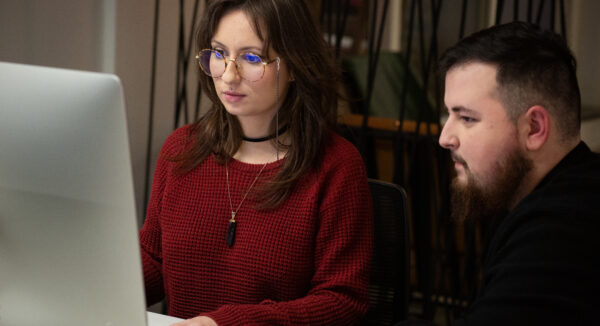
- Digital Business
When we think of Design, the images that come to our mind are often of elegant objects, grand architectural constructions, futuristic works of art, and brands known worldwide. However, Design is not only about form: it is also about function and people’s experience.
In the Development of digital products, Design appears in the interfaces of applications, systems, and platforms; and in the journeys and user experiences. Did you know that the area also supports the inception of digital solutions and their commercialization?
In the following article, we will discuss concepts of some types of Design, in order to clarify the various functionalities of the area so that you can choose one that suits your business.
There are several currents and trends that propose to conceptualize Design. In the book Design – History, Theory and Practice of Product Design, the author Bernhard E. Bürdek points out that most people’s lives are no longer imaginable without design. “Design follows us from morning until night: at home, at work, in leisure, in education, in health, in sports, in the transport of people and goods, in the public environment – everything is configured consciously or unconsciously”, he defines.
For the author, we communicate with people and define social groups through products. To understand this idea, just think about Apple. Anyone who has a device from this brand ends up belonging to a certain social group. In fact, Apple uses this awareness to create targeted advertisement that talks to this audience and further strengthens the sense of being part of such a community.
The definition by Tai Hsuan-An, author of the book Design: Concepts and methods, completes that of Bürdek, but relates more to the work of the designer: “Design is simply the professional activity that involves the entire process of creating and developing products, in order to meet the needs of the population in favor of a better and more pleasant life. These products are extremely varied in size, function, utility, style, material, complexity, quantity and breadth.”
In other words, design has the function of giving form to ideas and being the basis for the creation of products and services that meet people’s needs. But after all, what are the most known types of design in the universe of digital products, and what is their importance in the innovation journey?
Graphic Design is present in a very visible way in our daily lives. Its functionality consists of applying the art of design in graphic pieces. In these projects, the Designer creates solutions for digital and printed materials, which will be used in social networks, e-mail marketing, magazines, books, packaging, etc.
For this, it is necessary to have knowledge in visual communication, texts, typography, colors, layout and image editing software such as Photoshop, Illustrator and Canva. The main objective is to organize the most diverse information and convey a message that is clear, useful and interesting to the target audience.
Web Design is also one of the types of design. This aspect is fully connected to the internet universe, focusing on the creation of digital interfaces for websites. In this area, knowledge in HTML and CSS is crucial; after all, Web Designers are responsible for creating online pages. In this sense, creating quality interfaces has to do with some non-aesthetic factors, such as the image size, which impacts: page loading speed, and layout flexibility, which concerns the responsiveness of the websites.
Additionally, there are other types of design focused on digital solutions, which are very important to ensure the best usability. This is the case with UX Design. When we talk about User Experience (UX), we bring the needs of users and businesses to the heart of the debate. Among the responsibilities of UX Designers is the understanding of the product user, for better creation of user journeys. This professional may also be responsible for writing explanatory texts that make up the solution, an area called UX Writing.
When it comes to User Interface (UI), the main concern is to create the screens of the digital product. In this area, UI Designers are responsible for defining colors, typography, composition, Information Architecture, Interaction Design and UI Guidelines (iOS and Android) so that users can use the products in a simple and intuitive way.
We have already realized that in our routine we are impacted by design daily – both in physical and digital products – and that for the most different types of design there are the most varied forms of application. However, one area that we don’t always understand is Design Thinking. Much more than a buzzword in the technology world, this approach can be an excellent ally to solve problems and make important decisions that drive business evolution.
In the book Change by Design: How Design Thinking Transforms Organizations and Inspires Innovation, Tim Brown points out that Design Thinking explores capabilities that we all have, but which are neglected by more conventional problem-solving practices. “Design Thinking depends on our ability to be intuitive, to recognize patterns, to construct ideas that have emotional and functional meaning, to express ourselves in ways other than words or symbols. Nobody wants to run a business based on feeling, intuition and inspiration, but relying too much on the rational and the analytical can be just as dangerous.”
In recent years, large companies and startups have adopted this approach in their creation processes, with the mission of improving solutions and seeking innovation. Design Thinking can be applied to the development of applications, systems and platforms, and if you are thinking of creating a digital product, you will certainly need to use it. However, exploring this universe alone can be risky. After all, the approach has specific tools and practices that require knowledge. At SoftDesign, we solve problems based on the designer’s way of thinking through Design Thinking. Thus, we seek to understand the user’s perspective to test ideas and ensure the creation of an ideal product.
But we don’t use just Design Thinking. UX and UI Design also support us in various ways in our services. They are the starting point for investigating and understanding scenarios, problems and behaviors. Through them, we raise hypotheses, improve processes, create solutions and transform ideas into desirable products.
Now that you know, what types of designs need to be integrated into the development of your digital product, fill out the form below and talk to one of our experts. Together, we can shape your ideas.
Experience having a reliable partner to your IT challenges. Let’s talk about our unique approach to discover and deliver outstanding solutions.


